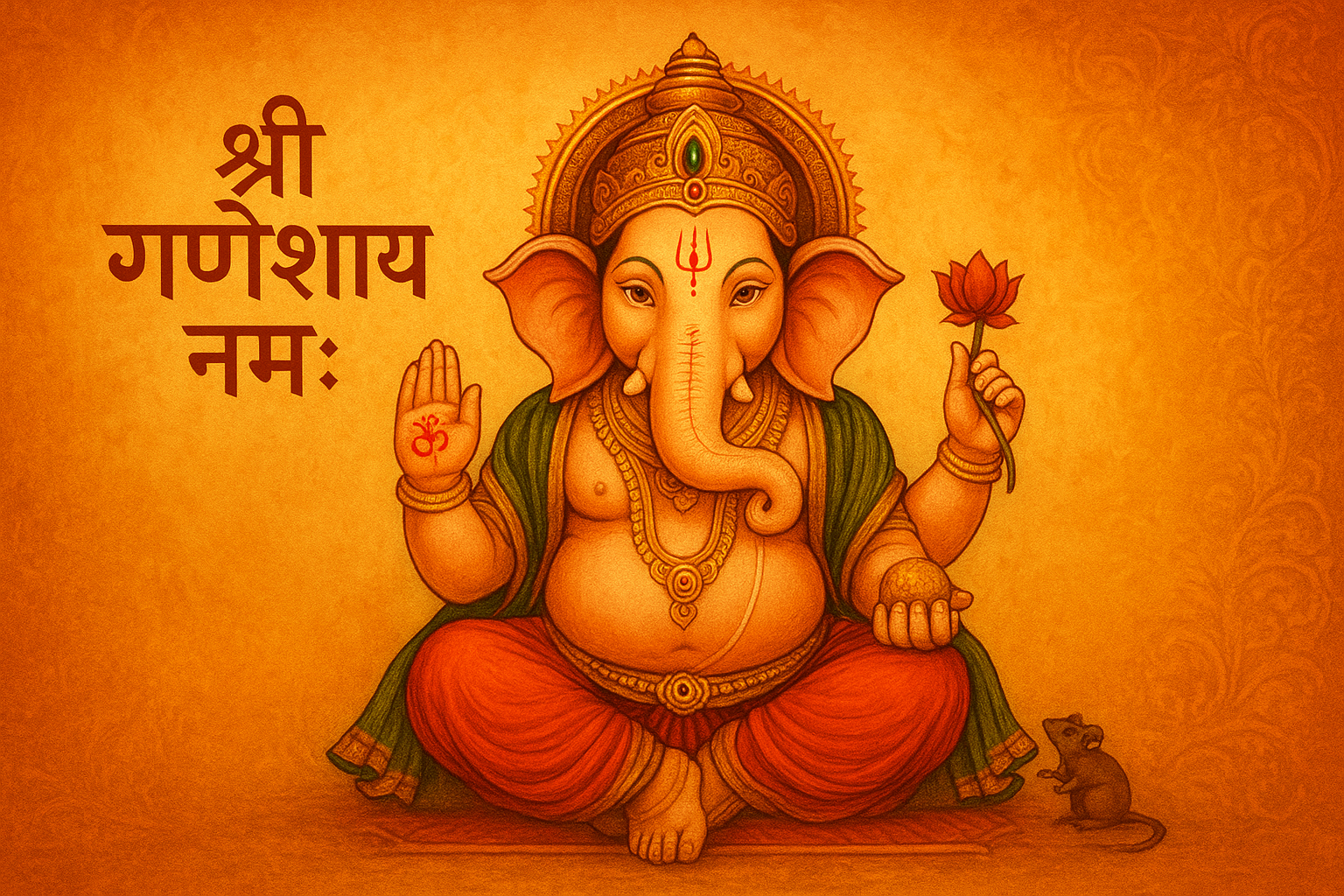Introduction
In the vast spiritual landscape of Sanatan Dharma, Shri Ganesh Bhagwan holds a revered place as the Vighnaharta (remover of obstacles) and Mangalakarta (harbinger of auspiciousness). Every prayer, ritual, and spiritual journey in Hindu tradition begins by invoking Lord Ganesha. His divine presence transcends geographical boundaries, celebrated with grandeur not only in India but also across the world.
Biographic Background of Shri Ganesh Bhagwan
Lord Ganesha, the son of Bhagwan Mahadev (Shiva) and Mata Parvati, is the most beloved deity in Hindu tradition. According to Purāṇic stories, Mata Parvati created Ganesha from the sandalwood paste she used for her bath, giving him life and assigning him the role of guarding her chamber. When Mahadev unknowingly returned and was denied entry by young Ganesha, a battle ensued. In the clash, Lord Shiva beheaded him. To console the grieving Parvati, Shiva promised to bring Ganesha back to life by placing the head of the first living being he found — an elephant. Thus, was born Gajānana, the elephant-headed God, symbolizing wisdom, strength, and compassion.
Why Lord Ganesh is Worshipped First?
Hindu scriptures proclaim:
“श्रीगणेशाय नमः।“
Śrī Gaṇeśāya Namaḥ – Salutations to Lord Ganesha.
Before any yajña, pūjā, marriage, or auspicious ritual, Lord Ganesha is invoked first. This tradition is rooted in the belief that he is the remover of obstacles (Vighnaharta) and ensures smooth beginnings. The Rigveda and Ganesha Atharvashirsha glorify him as the Adi-Pujya Devata, symbolizing the essence of intelligence (buddhi), success (siddhi), and prosperity (sampatti).
A popular shloka recited before every ritual is:
“वक्रतुण्ड महाकाय सूर्यकोटि समप्रभ।
निर्विघ्नं कुरु मे देव सर्वकार्येषु सर्वदा॥“
Vakratunda Mahakaya, Suryakoti Samaprabha;
Nirvighnam Kuru Me Deva, Sarva-Kaaryeshu Sarvada.
Meaning: O Lord with curved trunk, immense body, and brilliance equal to a million suns, please remove obstacles from all my works always.
Importance of Lord Ganesha in Sanatan Dharma
Lord Ganesha is not only a deity of auspicious beginnings but also symbolizes deeper philosophical truths:
- Elephant Head → Wisdom, memory, and intelligence.
- Large Ears → Ability to listen with patience.
- Small Eyes → Focus and concentration.
- Mouse as Vehicle (Mushak) → Humility and control over desires.
- Broken Tusk (Ekadanta) → Sacrifice and knowledge (he wrote the Mahabharata for Sage Vyasa).
Thus, Ganesha embodies both the worldly and the spiritual dimensions of life.
Names of Shri Ganesh and Their Significance
Lord Ganesha is adored by 108 names, each reflecting his qualities. Some popular ones include:
- Vighnaharta – Remover of obstacles
- Lambodara – One with a large belly (symbol of generosity)
- Ekadanta – One with a single tusk
- Gajānana – Elephant-faced one
- Vinayaka – Leader of all
- Siddhivinayaka – Bestower of success
- Mangalkarta – The one who brings auspiciousness
- Ganapati – Lord of all Ganas (celestial beings)
Devotees often chant the 108 Names of Ganesha (Ganesha Ashtottara Shatanamavali) during daily worship and Ganesh Chaturthi.
Festivals Associated with Lord Ganesha
1. Ganesh Chaturthi
The grandest celebration of Lord Ganesha is Ganesh Chaturthi, also known as Vinayaka Chaturthi. It marks the birth of Lord Ganesha and is observed with immense devotion in Maharashtra, Goa, Karnataka, Gujarat, and across India. Clay idols of Ganesha are installed in homes and public pandals, followed by 10 days of prayers, bhajans, cultural programs, and finally Visarjan (immersion) with chants of “Ganpati Bappa Morya, Pudhchya Varshi Lavkar Ya” (O Lord, come again soon next year).
2. Sankashti Chaturthi
Observed every month on the fourth day after the full moon, it is a fast dedicated to Ganesha, believed to remove difficulties.
3. Diwali’s First Day (Vagh Baras)
In many regions, Lord Ganesha is worshiped alongside Goddess Lakshmi to bless households with wealth and wisdom.
Maharashtra Ganesh Mahotsav – A Cultural Movement
The modern form of public Ganesh festival was popularized by Lokmanya Bal Gangadhar Tilak in 1893 to unite Indians during the freedom struggle. What started as a socio-religious movement has today become a cultural phenomenon.
- Mumbai’s Lalbaugcha Raja draws millions of devotees every year.
- Pune’s Dagadusheth Halwai Ganapati is world-famous for its grandeur.
- The festival blends spirituality with music, dance, social awareness campaigns, and community unity.
Ganesh Utsav Beyond Maharashtra
- In South India (Tamil Nadu, Andhra Pradesh, Karnataka) – Known as Vinayaka Chaturthi, celebrated with modak, kudumulu, and kozhukattai offerings.
- In Odisha – Observed as Ganesh Puja in schools and colleges for knowledge and wisdom.
- In West Bengal – Though overshadowed by Durga Puja, Ganesha is worshipped as the son of Durga.
- In Nepal – Ganesha is revered as an integral part of both Hindu and Buddhist traditions.
- Global Celebrations – From USA, UK, Canada, Mauritius, Singapore, to Dubai, Indian diaspora keeps the spirit of Ganesh Chaturthi alive, turning it into an international cultural festival.
Lord Ganesha in the World of Spirituality and Yoga
Ganesha is also associated with mantras and meditation practices. The Ganesha Mantra is widely recited for peace and prosperity:
“ॐ गं गणपतये नमः।“
Om Gam Ganapataye Namah – Salutations to Lord Ganesha, remover of obstacles.
This bija-mantra is believed to awaken positivity, courage, and clarity of thought.
Conclusion
Shri Ganesh Bhagwan is not just a deity but a universal symbol of wisdom, strength, and auspicious beginnings. From the lanes of Maharashtra to temples in Nepal and from Indian households to diaspora communities worldwide, Ganpati Bappa continues to inspire devotion and unity.
Invoking him before every new task reflects our deep-rooted belief in starting life’s journeys with clarity and blessings. Truly, Lord Ganesha is not just a god — he is the eternal Vighnaharta and Siddhivinayaka, guiding humanity toward success and happiness.
“सिद्धिविनायकं देवं सर्वकार्यार्थसिद्धये।
सर्वविघ्नहरं नित्यं वन्देऽहं गणनायकम्॥“

Leave a Reply